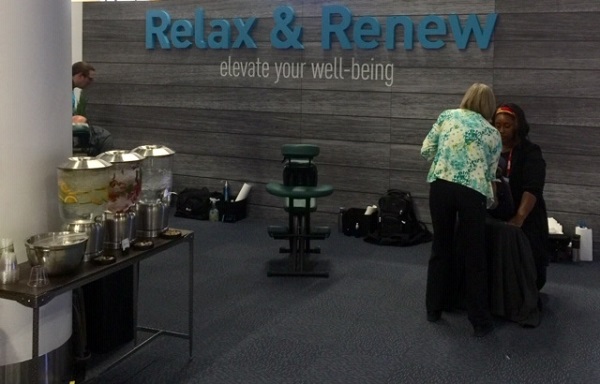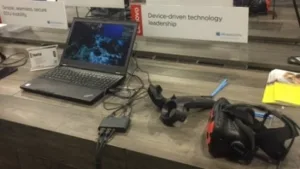Educause, the recent higher-ed conference held in Denver, had a lot to offer the post-secondary education ed-tech crowd. One of the most prominent themes in both the conference sessions and exhibit hall was the immersive learning craze.

At Educause, although the term XR superseded the usual AR/MR/VR nomenclature, the amour-of-the-day was VR, which held a remarkably strong position. Surprisingly, augmented reality had a much smaller presence in the exhibit hall and conference sessions than did virtual reality wares—usually AR presentations and booth presence slightly outnumber VR ones—but in this case, VR seemed to have a 3-1 advantage, numerically speaking.
Dell (above) featured their immersive cave experience, while Google featured VR simulations (below).
In the Educause exhibit hall, Google, Dell and Lenovo all offered front-featured, action-oriented VR displays. There was none of the low-end VR sundry that we see haunting K-12 ed-tech conferences. In terms of footprint, lab simulations—most made by Labster, who had elbowed or co-located their way into many of the expo hall booths—were the favored application for this deep thinking crowd. No vanilla VR field trips here.
Labster VR simulations were demonstrated at booths throughout the conference.
The conference sessions also evidenced a heavy emphasis on the XR theme. One of the best ways to reveal fast-track developments on the rise in education is through conference session analysis. The session offerings at Educause paint an interesting portrait of where VR is headed in education. For example, if you want to know what educators are thinking about VR—what may be keeping them up at night—glance at the pedagogy offerings that appear prominent:
- Virtual Reality: Advancing the Pedagogical Toolkit
- Developing Library Strategy for 3D and VR Collections
- Step Out of Your Head(set): Better Approaches for Collaborative Learning in Virtual Environments
- Creating Immersive Storytelling Learning Experiences in 360° Video
- Immersive Storytelling That Transforms Learning
- Virtual Holographic Simulation: Measuring Nursing Student Outcomes from Immersive Technology
In short, university educators are concerned with outcomes, simulations, storytelling, collaboration, pedagogy (not just the technology), acquisition and collection management.
Lenovo also featured their VR solutions at Educause.
A quick conference session analysis also enlightens us about future directions for higher-ed XR thinking (the italics are mine):
- HP Campus of the Future: How 3D Print, XR, and Open Educational Resources Are Advancing the Future of Higher Education (research)
- Ethics and Digital Fluency in VR and Immersive Learning Environments
- Bringing Virtual Reality into Higher Ed Communication
- eXtended Reality (XR): The New World of Human/Machine Interaction
Some of the more basic presentations related to XR may not be worth mentioning here, but one important gleaning is that higher ed is attempting to get together and talk about VR in small informal groups, such as was seen with the Extended Reality (XR) Community Group Session at Educause. In a final noteworthy observation, this was the first educational conference I have attended in which a rest and relaxation area included a virtual reality station. In a true yin and yang offering, one could enter the exhibit hall for the rush of adrenaline provided by VR or stop and rest in the Renewal Center to enjoy ;a restful beach or pastoral setting. – Len Scrogan
 Fruit-infused water, a massage or VR, Madam?
Fruit-infused water, a massage or VR, Madam?

